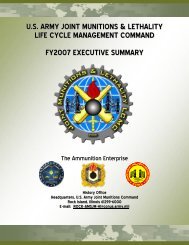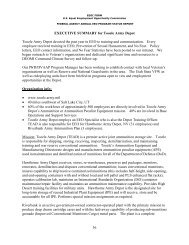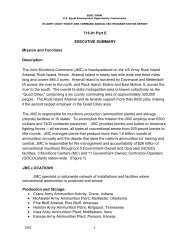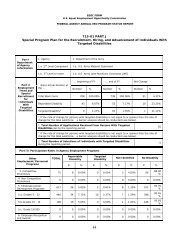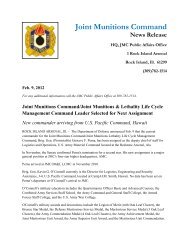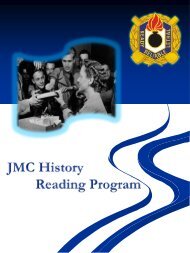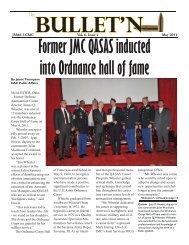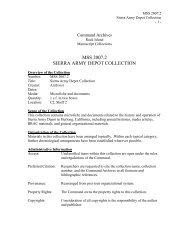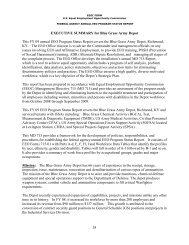History of the Ammunition Industrial Base - JMC - U.S. Army
History of the Ammunition Industrial Base - JMC - U.S. Army
History of the Ammunition Industrial Base - JMC - U.S. Army
Create successful ePaper yourself
Turn your PDF publications into a flip-book with our unique Google optimized e-Paper software.
subject to special control. Numerous factors affected <strong>the</strong> shortages to include: marginal<br />
worldwide stocks, initial readiness <strong>of</strong> <strong>the</strong> production base, expenditure rates due to <strong>the</strong> nature <strong>of</strong><br />
warfare and insufficient allowance for requirements for surges and escalation <strong>of</strong> conflict. 125<br />
Vietnam showed that major fluctuations in combat caused <strong>the</strong> provisions for a reasonable<br />
safety level <strong>of</strong> stocks above estimated consumption quantities is needed to keep continuous<br />
pressure on <strong>the</strong> pipeline during periods <strong>of</strong> unforeseen escalation. R.J Hammond claims that <strong>the</strong><br />
establishment modernization and expansion <strong>of</strong> a production base in <strong>the</strong> country must be<br />
segregated from <strong>the</strong> use <strong>of</strong> requirements that drive and justify its retention. He believed <strong>the</strong> core<br />
base should be kept independent <strong>of</strong> requirements to realign focus on modernization and retention<br />
<strong>of</strong> <strong>the</strong> facilities that remained. 126<br />
The pattern <strong>of</strong> setting production capability based on requirements from WWII through<br />
Vietnam shows that fluctuations, consumption, <strong>Army</strong> manpower, warfare, policy, budgets and<br />
many o<strong>the</strong>r factors compound <strong>the</strong> ability to determine <strong>the</strong> right size for <strong>the</strong> ammunition industrial<br />
base. By Vietnam almost all available capacity and installations were needed to meet modern<br />
requirements. After Vietnam <strong>the</strong> Single Manager concept was established to centralize <strong>the</strong><br />
management <strong>of</strong> all Services conventional ammunition.<br />
A Single Manager For Conventional <strong>Ammunition</strong> (SMCA) 127<br />
The Single Manager for Conventional <strong>Ammunition</strong> (SMCA) was formed in 1977 to<br />
consolidate management <strong>of</strong> ammunition across DoD. The DoD assigned <strong>the</strong> single manager<br />
duties to <strong>the</strong> Department <strong>of</strong> <strong>the</strong> <strong>Army</strong>, who delegated <strong>the</strong> execution <strong>of</strong> <strong>the</strong> mission to <strong>the</strong> <strong>Army</strong><br />
Materiel Command (AMC). AMC fur<strong>the</strong>r delegated <strong>the</strong> day to day operations to <strong>the</strong> <strong>Army</strong><br />
Armament Command (ARMCOM). ARMCOM completed implementation plans, but <strong>the</strong><br />
SMCA mission actually went to ARMCOM‟s successor, <strong>Army</strong> Armament Materiel Readiness<br />
Command (ARRCOM) when that command was activated in FY77. While changes in <strong>the</strong><br />
delegation <strong>of</strong> SMCA responsibilities have occurred over <strong>the</strong> years, <strong>the</strong> SMCA primary field<br />
operating activity has remained at Rock Island as an element <strong>of</strong> <strong>the</strong> ammunition management<br />
mission <strong>of</strong> <strong>the</strong> successor commands to ARRCOM: <strong>Army</strong> Armament, Munitions and Chemical<br />
Command (AMCCOM, FY 83-94); <strong>Army</strong> <strong>Industrial</strong> Operations Command (IOC, FY 95-99);<br />
<strong>Army</strong> Operations Support Command (OSC, FY00 to FY02), and <strong>Army</strong> Field Support<br />
Command/Joint Munitions Command (Provisional)(AFSC and <strong>JMC</strong>, FY02 to FY06) to <strong>the</strong> Joint<br />
Munitions Command in FY06 in conjunction with <strong>the</strong> newly formed Joint Munitions & Lethality<br />
Life Cycle Management Command (JM&L LCMC) in FY07.<br />
The early intent <strong>of</strong> <strong>the</strong> Single Manager concept was to eliminate overlap and duplication<br />
<strong>of</strong> production efforts among <strong>the</strong> Services. In early assignments <strong>the</strong> Single Manager was given<br />
total control over a certain set <strong>of</strong> homogenous Federal Stock Classes with no deviations or<br />
exceptions. Early thought had been to give R&D to <strong>the</strong> Single Manager, but <strong>the</strong> Services<br />
overruled that idea. At <strong>the</strong> wholesale level <strong>the</strong> Single Manager was concerned with net<br />
125 Ibid, 146.<br />
126 Hammond, 138.<br />
127 SMCA section is extracted from a paper George Eaton wrote on <strong>the</strong> evolution <strong>of</strong> SMCA. See: George Eaton.<br />
Matching Organization to Expectation: A <strong>History</strong> <strong>of</strong> <strong>the</strong> Single Manager for Conventional <strong>Ammunition</strong>: 1950 to<br />
2004 (AFSC/<strong>JMC</strong> <strong>History</strong> Office, Rock Island: 2005), passim.<br />
41



